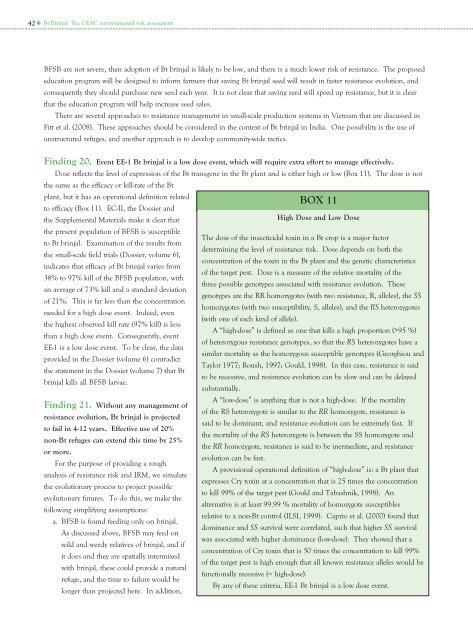Bt Brinjal The scope and adequacy of the GEAC environmental risk assessment
Bt Brinjal: The scope and adequacy of the GEAC ... - Down To Earth
Bt Brinjal: The scope and adequacy of the GEAC ... - Down To Earth
- No tags were found...
Create successful ePaper yourself
Turn your PDF publications into a flip-book with our unique Google optimized e-Paper software.
42 <strong>Bt</strong> <strong>Brinjal</strong>: <strong>The</strong> <strong>GEAC</strong> <strong>environmental</strong> <strong>risk</strong> <strong>assessment</strong>BFSB are not severe, <strong>the</strong>n adoption <strong>of</strong> <strong>Bt</strong> brinjal is likely to be low, <strong>and</strong> <strong>the</strong>re is a much lower <strong>risk</strong> <strong>of</strong> resistance. <strong>The</strong> proposededucation program will be designed to inform farmers that saving <strong>Bt</strong> brinjal seed will result in faster resistance evolution, <strong>and</strong>consequently <strong>the</strong>y should purchase new seed each year. It is not clear that saving seed will speed up resistance, but it is clearthat <strong>the</strong> education program will help increase seed sales.<strong>The</strong>re are several approaches to resistance management in small-scale production systems in Vietnam that are discussed inFitt et al. (2008). <strong>The</strong>se approaches should be considered in <strong>the</strong> context <strong>of</strong> <strong>Bt</strong> brinjal in India. One possibility is <strong>the</strong> use <strong>of</strong>unstructured refuges, <strong>and</strong> ano<strong>the</strong>r approach is to develop community-wide tactics.Finding 20. Event EE-1 <strong>Bt</strong> brinjal is a low dose event, which will require extra effort to manage effectively.Dose reflects <strong>the</strong> level <strong>of</strong> expression <strong>of</strong> <strong>the</strong> <strong>Bt</strong> transgene in <strong>the</strong> <strong>Bt</strong> plant <strong>and</strong> is ei<strong>the</strong>r high or low (Box 11). <strong>The</strong> dose is not<strong>the</strong> same as <strong>the</strong> efficacy or kill-rate <strong>of</strong> <strong>the</strong> <strong>Bt</strong>plant, but it has an operational definition relatedto efficacy (Box 11). EC-II, <strong>the</strong> Dossier <strong>and</strong><strong>the</strong> Supplemental Materials make it clear that<strong>the</strong> present population <strong>of</strong> BFSB is susceptibleto <strong>Bt</strong> brinjal. Examination <strong>of</strong> <strong>the</strong> results from<strong>the</strong> small-scale field trials (Dossier, volume 6),indicates that efficacy <strong>of</strong> <strong>Bt</strong> brinjal varies from38% to 97% kill <strong>of</strong> <strong>the</strong> BFSB population, withan average <strong>of</strong> 73% kill <strong>and</strong> a st<strong>and</strong>ard deviation<strong>of</strong> 21%. This is far less than <strong>the</strong> concentrationneeded for a high dose event. Indeed, even<strong>the</strong> highest observed kill rate (97% kill) is lessthan a high dose event. Consequently, eventEE-1 is a low dose event. To be clear, <strong>the</strong> dataprovided in <strong>the</strong> Dossier (volume 6) contradict<strong>the</strong> statement in <strong>the</strong> Dossier (volume 7) that <strong>Bt</strong>brinjal kills all BFSB larvae.Finding 21. Without any management <strong>of</strong>resistance evolution, <strong>Bt</strong> brinjal is projectedto fail in 4-12 years. Effective use <strong>of</strong> 20%non-<strong>Bt</strong> refuges can extend this time by 25%or more.For <strong>the</strong> purpose <strong>of</strong> providing a roughanalysis <strong>of</strong> resistance <strong>risk</strong> <strong>and</strong> IRM, we simulate<strong>the</strong> evolutionary process to project possibleevolutionary futures. To do this, we make <strong>the</strong>following simplifying assumptions:a. BFSB is found feeding only on brinjal.As discussed above, BFSB may feed onwild <strong>and</strong> weedy relatives <strong>of</strong> brinjal, <strong>and</strong> ifit does <strong>and</strong> <strong>the</strong>y are spatially intermixedwith brinjal, <strong>the</strong>se could provide a naturalrefuge, <strong>and</strong> <strong>the</strong> time to failure would belonger than projected here. In addition,BOX 11High Dose <strong>and</strong> Low Dose<strong>The</strong> dose <strong>of</strong> <strong>the</strong> insecticidal toxin in a <strong>Bt</strong> crop is a major factordetermining <strong>the</strong> level <strong>of</strong> resistance <strong>risk</strong>. Dose depends on both <strong>the</strong>concentration <strong>of</strong> <strong>the</strong> toxin in <strong>the</strong> <strong>Bt</strong> plant <strong>and</strong> <strong>the</strong> genetic characteristics<strong>of</strong> <strong>the</strong> target pest. Dose is a measure <strong>of</strong> <strong>the</strong> relative mortality <strong>of</strong> <strong>the</strong>three possible genotypes associated with resistance evolution. <strong>The</strong>segenotypes are <strong>the</strong> RR homozygotes (with two resistance, R, alleles), <strong>the</strong> SShomozygotes (with two susceptibility, S, alleles), <strong>and</strong> <strong>the</strong> RS heterozygotes(with one <strong>of</strong> each kind <strong>of</strong> allele).A “high-dose” is defined as one that kills a high proportion (>95 %)<strong>of</strong> heterozygous resistance genotypes, so that <strong>the</strong> RS heterozygotes have asimilar mortality as <strong>the</strong> homozygous susceptible genotypes (Georghiou <strong>and</strong>Taylor 1977; Roush, 1997; Gould, 1998). In this case, resistance is saidto be recessive, <strong>and</strong> resistance evolution can be slow <strong>and</strong> can be delayedsubstantially.A “low-dose” is anything that is not a high-dose. If <strong>the</strong> mortality<strong>of</strong> <strong>the</strong> RS heterozygote is similar to <strong>the</strong> RR homozygote, resistance issaid to be dominant, <strong>and</strong> resistance evolution can be extremely fast. If<strong>the</strong> mortality <strong>of</strong> <strong>the</strong> RS heterozygote is between <strong>the</strong> SS homozygote <strong>and</strong><strong>the</strong> RR homozygote, resistance is said to be inermediate, <strong>and</strong> resistanceevolution can be fast.A provisional operational definition <strong>of</strong> “high-dose” is: a <strong>Bt</strong> plant thatexpresses Cry toxin at a concentration that is 25 times <strong>the</strong> concentrationto kill 99% <strong>of</strong> <strong>the</strong> target pest (Gould <strong>and</strong> Tabashnik, 1998). Analternative is at least 99.99 % mortality <strong>of</strong> homozygote susceptiblesrelative to a non-<strong>Bt</strong> control (ILSI, 1999). Caprio et al. (2000) found thatdominance <strong>and</strong> SS survival were correlated, such that higher SS survivalwas associated with higher dominance (low-dose). <strong>The</strong>y showed that aconcentration <strong>of</strong> Cry toxin that is 50 times <strong>the</strong> concentration to kill 99%<strong>of</strong> <strong>the</strong> target pest is high enough that all known resistance alleles would befunctionally recessive (= high-dose).By any <strong>of</strong> <strong>the</strong>se criteria, EE-1 <strong>Bt</strong> brinjal is a low dose event.











